#Slender Snipe Eel
Explore tagged Tumblr posts
Text
@phynali Good morning treasured mutual. I have decided you need to know about the snipe eel's existance

Behold!

Slender snipe eels which according to wiki have more vertebra than any other animal. Around 750.
0 notes
Text
Introducing: Double Mermay!!
A challenge where you use the regular Mermay prompts, as well as a randomly selected fish to base the drawing/character off of! You can use any list of fish you want, but here’s the one I’m using! (Deep sea fish)
Slender Snipe Eel
Viperfish
Gulper Eel
Barreleye
Ribbon Sawtail Fish
Sarcastic Fringehead
Marine Hatchetfish
Atlantic Hagfish
Frilled Shark
Chimaera
Fangtooth
Hadal Snailfish
Mueller Fish
Lophiomus
Coelacanth
Stargazer Fish
Goblin Shark
Zombie Worms
Predatory Tunicate/Ghostfish
Vampire Squid
Tripod Fish
Dumbo Octopus
Boa Dragonfish
Snailfish
Highfin Lizard Fish
Blind Eel
Parasitic Louse
Roughhead Grenadier
Solumbellula Sea Pen
Sea Pig
Siphonophore
Ghost Shark
Cookiecutter Shark
Bobbit Worm
Yeti Crab
Pompeii Worm
Red-Lipped Batfish
Hairy Anglerfish
Pink Sea-Through Fantasia
Christmas Tree Worm
Basket Star
Whale Shark
Phronima Sedentaria
Promachoteuthis Sulcus
Terrible Claw Lobster
Pacific Blackdragon
Mantis Shrimp
Also all of the regular Mermay prompts!

1 note
·
View note
Photo

Slender Snipe Eel (Nemichthys scolopaceus)
Family: Snipe Eel Family (Nemichthyidae)
IUCN Conservation Status: Unassessed
Named for its elongated jaws that resemble the beak of a snipe, the Slender Snipe Eel is an illusive and poorly understood fish, with most of what is known about it coming from a handful of brief encounters with live individuals (although the remains of this species are frequently found in the stomachs of larger fish caught by fishers.) Found in non-polar waters worldwide, it inhabits the mesopelagic and bathypelagic zone (at depths of 200-4,000m/656-13123ft) and feeds on swimming crustaceans which it catches using a series of tiny teeth that line its long, curved jaws. Although adults of this species may grow to be up to 1.3 meters (4ft) long, their extremely slender body means that they weigh less than 100 grams (3.5 ounces), with their thin, lightweight bodies possibly being an adaptation that makes them harder for prey and predators such as tunas (some species of which may dive to great depths to hunt snipe eels) to detect in the darkness of their deepwater home. Slender Snipe Eels are believed to reproduce through broadcast spawning (meaning they release gametes freely into the water without finding a mate, with the gametes meeting in the water) and die after mating; their larvae, bizarrely, begin their lives with broad, leaf-shaped bodies and “slim down” as they age. The spine of a Slender Snipe Eel contains as many as 750 vertebrae, which vastly surpasses the number seen in any other vertebrate (for reference, humans have just 33 and even Blue Whales, the longest vertebrates, have at most 65.)
--------------------------------------------------------------------------
Image Source: https://www.inaturalist.org/taxa/67619-Nemichthys-scolopaceus
#Slender Snipe Eel#snipe eel#eel#eels#fish#fishes#zoology#biology#icthyology#animal#animals#wildlife#marine wildlife#cosmopolitan wildlife#deep-sea animals#marine biology#marine animals#deep-sea fishes#noodle boys
114 notes
·
View notes
Photo

The larvae of the slender snipe eel [Nemichthys scolopaceus], a fish which can reach lengths of over 5 feet while simultaneously weighing only a few ounces. These fish also have around 750 vertebrae, more than any other animal known. Image by LarvalBase.
273 notes
·
View notes
Video
tumblr
It’s officially Monday, and we’re officially not moving.
This unique deep-sea resident is Avocettina bowersii, also known as a snipe eel. These slender eels are observed at depths ranging from 90 to 2,700 meters (295 to 8,860 feet) below the ocean’s surface.
Snipe eels in the family Nemichthyidae have thin, tweezer-like jaws that bend outwards. It was long debated how these fish actually eat, but we now know that they have tiny, backward-facing teeth that work almost like velcro. They use them to capture small crustaceans and bring prey into their mouths with a series of rapid chomps.
#MBARI#DeepSea#SeaLife#MondayMood#MondayMornings#MondayVibe#MondayMotivation#MomentOfZen#IfWeDontMoveMondayCantSeeUs
125 notes
·
View notes
Text
in case you where wondering what this weird fishenthusiast has been doing:
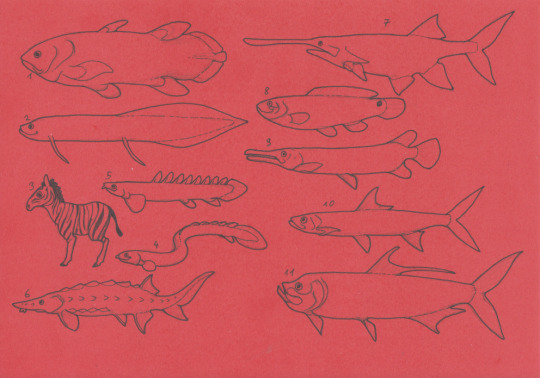
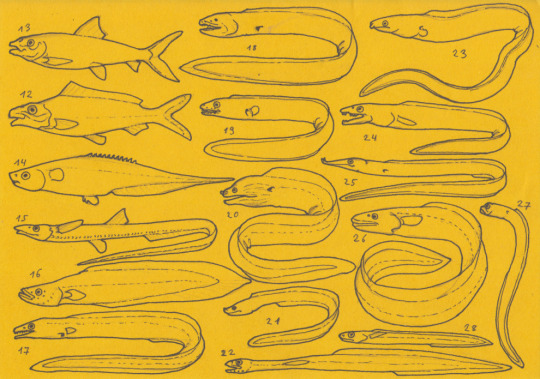


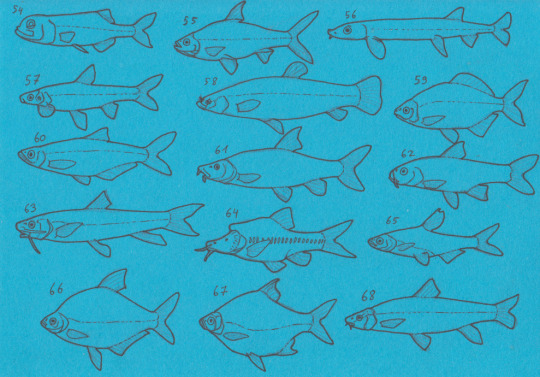
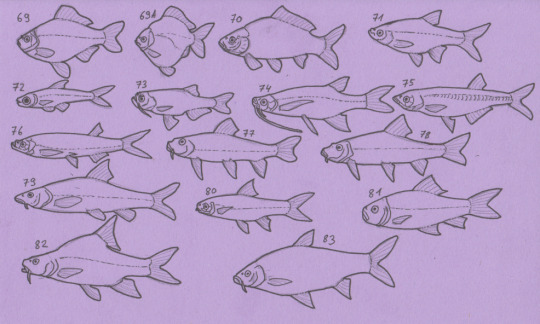
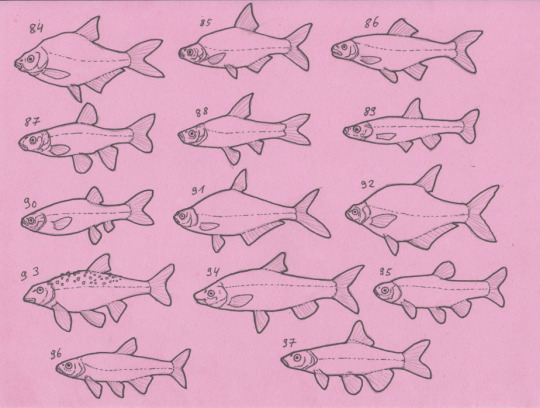
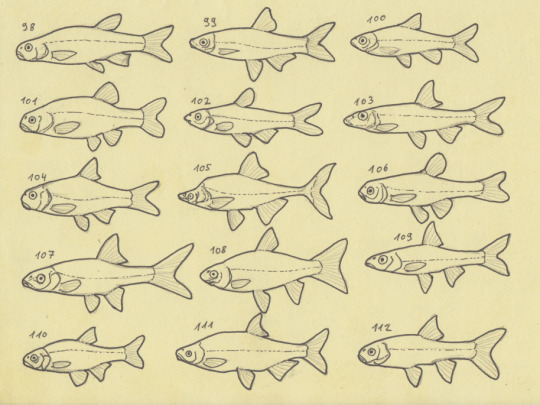
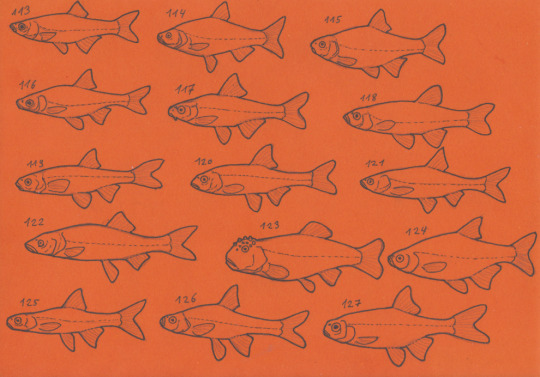
1 Coelacanth 2 Lungfish 3 Tetrapod 4 Ropefish 5 Bichir 6 Sturgeon 7 Paddlefish 8 Bowfish 9 Gar (messed up Maxillary needs correction) 10 Ladyfish 11 Tarpon 12 Japanese gissu 13 bonefish 14 deep sea spiny eel 15 Halosaur 16 Protanguilla 17 cutthroat eel 18 Mud eel 19 thin eel 20 moray eel 21 false moray (u r a FRAUD!) 22 longneck eel 23 snake eel 24 pike conger 25 duckbill eel 26 conger 27 garden eel 28 Bathymyrinae 29 spaghetti eel 30 pelican eel 31 Saccopharynx 32 onejaw gulpers 33 bobtail snipe-eel 34 freshwater eel 35 snipe eel 36 sawtooth eel 37 Mooneye 38 freshwater butterflyfish 39 arowana 40 knifefish 41 aba 42 freshwater elephantfish 43 anchovi 44 denticle herring 45 Pellona 46 Pristigaster 47 wolf herring 48 round herring 49 herring 50 sardine 51 sprat 52 menhaden 53 sprat 54 Slickhead 55 milkfish 56 beaked salmon 57 shellear 58 hingemouth 59 bitterling 60 bleak 61 barbel 62 redfin 63 snowtrout 64 Golden-Line fish 65 sharpbelly 66 white amur bream 67 tinfoil barb 68 khramulyas 69 crucian carp 69A ryukin goldfish 70 common carp 71 carplet 72 rasbora 73 danio 74 flying barb 75 silver cyprinid 76 razorbelly minnow 77 false gudgeons 78 gudgeon 79 steed 80 mud carp 81 labeo 82 yellowfish 83 Leptobarbus 84 common bream 85 bleak 86 chiselmouth 87 longfin dace 88 mexican chub 89 spanish minnowcarp 90 aztec chub 91 bream 92 silver bream 93 stoneroller 94 nase 95 dace 96 redside dace 97 ornate shiner 98 lake chub 99 satinfin shiner 100 desert minnow 101 desert dace 102 longjaw minnow 103 slender chub 104 cutlips minnow 105 western chub 106 flame chub 107 california (roll ) roach 108 silvery minnow 109 bigeye chub 110 least chub 111 hitch 112 spinedace 113 moderlieschen 114 eurasian dace 115 highscale shiner 116 finescale shiner 117 blacktail chub 118 pearl dace 119 spikedace 120 moapa dace 121 peamouth 122 hardhead 123 hornhead chub 124 golden shiner 125 eastern shiner 126 pugnose minnow 127 oregon chub And I am NOWHERE NEAR finished!
2K notes
·
View notes
Photo










16/04/22-Part 2 of 2: Lodmoor
Following on my my previous post, we then called into nearby Lodmoor where there were many more avian delights on a walk in gorgeous sunshine. The bright colours of Mediterranean Gull another special bird to hear and see today, bronzed Black-tailed Godwits and more lovely Shelducks were great to see on a walk round as were some stunning Snipes. Greenfinch looked dashing at the end and there were some more great close views of Gadwall like the one in the third picture I took today in this photoset. Near to a residential area I very much enjoyed seeing House Sparrows taking blossom either eating the blossom or taking it for nesting I believe in the golden sunlight something so interesting to see. I took some photos of this including the fourth picture in this photoset.
Peacocks were a regular sight at Lodmoor too, and we saw a Speckled Wood well. Cow parsley, lesser celandine, lots of lovely daisies, dandelions, shadows of sedum, green alkanet, periwinkles, hyacinth and buttercup were lovely flowers to see here too. There was some amazing blossom to see of great colours on this walk with gorse and reedbeds mixing so well in hazier sunny scenes lending itself well to the extensive views from here. I took the first two and fifth pictures in this photoset of views here today and sixth of some stunning blossom. On the way home I noticed the famous sign post to this place the white horse was surrounded nicely by gorse and I reflected on what an amazing year I have had for seeing gorse so far especially these past few weeks.
As we chatted to a lovely couple at the hut area who had just admired like us a Wren showing and singing well on this gorgeous day I took the seventh picture in this photoset of that, we ended the day amazingly with another year tick and another astonishing natural moment. The tick was a slender Common Tern drifting through the air, a migrant that was another key target lately that later in the year at Lodmoor we would be fairly sure to see but I didn’t know if we’d sneak a sighting in today or not early on with them just arriving on these shores again but we did and I am over the moon with this. It feels so good to get my year of terns begun a key bird of this time of year. This takes my bird year list to 149.
Then a Grey Heron that we had been getting cracking views of edged closer before catching an eel with its bill, and it proceeded to devour it further back on some grass. The eel put up a pretty good fight though it’s such a slippery fish. The Grey Heron managed to swallow it, and then went in for a second coming to the same area of water and as we left it was looking to eat the second having taken it to a similar area in the grass. Such a simple piece of behaviour, but one we maybe rarely get the chance to stand and watch. And what an intimate glimpse into the world of this characteristic bird this gives us. I took the eighth picture in this photoset of the Grey Heron and ninth of it with the eel on the ground whilst it was trying to eat it. A perfect end to our time in Weymouth today.
Birches and gorse looked lovely in the sunlight coming through the New Forest on the way home tonight. At home as hoped I saw and photographed a cracking sunset and saw the brilliant pink moon a full moon I had looked forward taking photos of that too including the tenth and final in this photoset. Today was what bank holidays are all about for me, relaxing and enjoying some brilliant time out well in a cracking wild further afield trip. And Dorset trips are often a key part of our Easter and bank holiday weekends in general. And it was what Easter is all about for me today as it was the personification of spring. What a day! Wildlife Sightings Summary for Lodmoor: My first Common Tern of the year, two of my favourite birds the Little Egret and Shelduck, Carrion Crow, Magpie, Woodpigeon, Collared Dove, Feral Pigeon, Greenfinch, Blue Tit looking nice in a green tree, Long-tailed Tit, Chiffchaff, Dunnock, Wren, House Sparrow, Grey Heron, Snipe, Oystercatcher, Black-tailed Godwits, Cormorant, Herring Gull, Black-headed Gull, Mediterranean Gull, Canada Goose, Coot, Moorhen, Mute Swan, Mallard, Gadwall, Tufted Duck, Teal closely, Speckled Wood, Peacock, Brown Rat, eel and we heard Cetti’s Warbler.
Part 1 of today’s posts is here: https://dansnaturepictures.tumblr.com/post/681728232861630464/160422-part-1-of-2-radipole-lake-and-some-bits
#cetti's warbler#photography#england#uk#earth#nature#world#birdwatching#birds#carrion crow#common tern#little egret#lodmoor#rspb lodmoor#shelduck#magpie#woodpigeon#collared dove#feral pigeon#greenfinch#snipe#grey heron#fish#black-headed gull#mediterranean gull#water#water birds#photos#dunnock#chiffchaff
3 notes
·
View notes
Photo

Slender snipe eel. Zoologica. 1937.
Internet Archive
137 notes
·
View notes
Text
@oldbirdbrain replied to your post ““Didja know the Slender Snipe Eels butthole is on its throat, nano...”
"I think ol' Raven could'a gone his whoooole life without know'n that, honey. Would'a preferred it that way too!"

“The didja know Vampire squids turn themselves inside out in a way~ Or that the start sunfish can grow up ta twenty arms and detach ‘em at will?”
1 note
·
View note
Text
Runners-up:
Acorn weevil (Curculio glandium) (see above)
Slender snipe eel (Nemichthys scolopaeus)

Mosquito (Aedes aegypti)

Bluespotted cornetfish (Fistularia commersonii)

Elephant shrew (Elephantulus myurus)

African Elephant (Loxodonta africana)

Super special fictional creature mention: nasobeme/snouter (Nasobema lyricum)

top 10 snout animals
10. Avocet

9. Borzoi

8. Bilby

7. Gharial

6. Armadillo

5. Needlefish

4. Garden Eel (this counts ok@?)

3. Toucan

2. Long-Snout Clingfish

1. Anteater

5K notes
·
View notes
Text
The slender snipe eel
YUCK

fun facts:
“The slender snipe eel is a deep sea, bathypelagic species occuring from the surface down to many hundred meters in depth!!!!!!”
“The snipe eel, known to science as Nemichthys scolopaceus, is a rather peculiar looking fish. It has a long body, up to five feet in length, and resembles a long piece of ribbon or string with a large bulbous head at one end”


Facts:
Scientific name:
Nemichthys scolopaceus
Taxonomic Classification:
Kingdom: Animalia
Phylum: Chordata
Class: Actinopterygii
Order: Anguilliformes
Family: Nemichthyidae
Genus: Nemichthys
Species: N. scolopaceus
Growth and development:
The snipe eel, known to science as Nemichthys scolopaceus, is a rather peculiar looking fish. It has a long body, up to five feet in length, and resembles a long piece of ribbon or string with a large bulbous head at one end.
Common name:
slender snipe eel
Nutritional requirement:
The only food items actually found in the stomachs of snipe eels have been shrimp-like crustaceans, though ichthyologists believe they should be capable of catching and eating small fish and cephalopods also
Behavior:
The slender snipe eel is an active predator that feeds on pelagic crustaceans in the dark of the deep ocean. ... The conservation status of the slender snipe eel is not known, but it is likely naturally rare. It is not targeted for human use and is rarely captured in fisheries targeting other species.
Habitat:
The bobtail snipe eels are two species of deep-sea fishes in the family Cyematidae, one only in each of two genera. They are small elongate fishes, growing up to 16 centimeters (6.3 inches) long. They are bathypelagic (deep-water ocean-dwellers) and have been found down to 5,000 meters (16,000 feet)
Reproduction:
Larger fishes, including some shallow water species that dive to feed (e.g., some tunas), eat slender snipe eels. This species reproduces via broadcast spawning, a process by which females release their eggs and males release their sperm into the water column at the same time.
Evolutionary Origins:
The conservation status of the slender snipe eel is not known, but it is likely naturally rare. It is not targeted for human use and is rarely captured in fisheries targeting other species. However, as commercial fishers fish deeper and deeper, targeting new species of fishes and invertebrates, it is possible that the slender snipe eel could be more regularly affected by these activities. Therefore, it is important to continue to study this and similar species, in order to determine population trends and learn more about the life history of species in the deep sea



site sources:
https://en.wikipedia.org/wiki/Slender_snipe_eel
http://www.seasky.org/deep-sea/snipe-eel.html
https://www.google.com/search?biw=1366&bih=588&ei=yfAqWpu3F6rVjwT9vpmgDA&q=snipe+eels+reproduction&oq=snipe+eels+reproduction&gs_l=psy-ab.3..33i160k1.180923.184646.0.185195.12.12.0.0.0.0.307.1369.2j8j0j1.11.0....0...1.1.64.psy-ab..1.11.1364...33i21k1.0.EqyHx1499Q0
http://oceana.org/marine-life/ocean-fishes/slender-snipe-eel
https://www.google.com/search?q=snipe+eels+origins&source=lnms&tbm=isch&sa=X&ved=0ahUKEwihm6i7nPvXAhUB2oMKHd6vC1gQ_AUICigB&biw=1366&bih=588#imgrc=-lIjmas5Lwtc-M:
1 note
·
View note
Text
Crested caracara
Deepstaria jellyfish
Oropendola
Hammerhead salamander
Armored bush cricket
Curetis acuta caterpillar
Fish scale gecko. what the hell is this lil guy doing
Everyone knows what a king cobra is but did you know that they GROWL????? WHAT?????
Pika bunny
Big headed turtle
Mexican mole lizard
Nicobar pigeon
Black-napped pheasant pigeon
Batfish
Slender snipe eel
Barbados threadsnake
Lacewing larvae, who collect and cover themselves with aphid molt exoskeletons, possibly to camouflage themselves while hunting aphids
Chlamisus or Fulcidax leaf beetles
Everyone knows what a barracuda is. but Ive never seen any educational coverage of it. I dont know a thing about barracudas besides their diet of cute animated clown fish families. I just saw a video of a small shark chillin in the shallows, and out of NOWHERE it gets blasted by a barracuda that was AT LEAST 6 feet long (sharkie was fine) WHO was gonna tell me that barracudas are THAT FUCKING BIG??? huh???? I was just supposed to FIND THAT OUT????
Cup moths and their jelly bean caterpillars
Greater prairie chicken
Luzon bushy-tailed cloud rat
Apparently Baquila trifoliolata is NOT the only plant with light sensitive cells, there is also Arabidopsis mustard and however the hell you spell the last one
Ghost cicada
Thomisus onustus
Scorpion fly
Plume moths
Golden tortoise beetle
Thorny crickets
Arsenure drucei moth catterpillar
Happy faced spider
Long horned orbweaver
Devils flower mantis
Cassius owlet catterpillar
Orchid bee
Any moon moth that's not the north american version
Equatorial velvet worm
animals that are extremely cool but I only found out about by chance because every single animal program and article focuses on famous animals like tigers and polar bears and eye-eyes:
Civet
Aardwolf
Cloud rat
Binturong
Painted dogs
Takin
Oarfish
Dik-dik
Mouse deer
I checked and dik-diks and the mouse deer are different
Honestly any deer that isn’t white tail, red, reindeer, elk, or moose
Like that striped deer, the lowland nyala???? especially the females???? fantastic
that fanged deer?????? HELL yeah
King vulture
Numbat
Bearded vulture
Bush dog
feel free to add, I will when I stumble on super cool unknown animals
#this edition goes out to my english teacher who interrupted me talking about cats to say that they dont growl#no ms short they dont growl like a DOG that just what you call the low angry meow they make#kind of like this COBRA#AND ALSO#MY CAT MORE THAN ONCE HAS MADE A VERY DOG LIKE GROWL SO THERE#speaks#long
135 notes
·
View notes
Photo

Slender Snipe Eel, Conger Eel, Moray, etc. Vintage 1984
3 notes
·
View notes
Photo

Slender snipe eel or #Nemichthys scolopaceus is a odd abyssal fish. In photos I show #taxidermy for sale of several specimens. #slendersnipeeel #cabinetofcuriosities #taxidermyforsale #fishing #taxidermyfish #cabinetofcuriosity #deepseafish #剥製 #剥製販売 #海の怪物 #深海魚 #深海魚 (en Mar Mediterraneo) https://www.instagram.com/p/B2o90O3oqVO/?igshid=1cxs4kk3kzzt3
#nemichthys#taxidermy#slendersnipeeel#cabinetofcuriosities#taxidermyforsale#fishing#taxidermyfish#cabinetofcuriosity#deepseafish#剥製#剥製販売#海の怪物#深海魚
0 notes
Photo

Nemichthys scolopaceus, Slender snipe eel, larval stages. Zoologica. 1937.
Internet Archive
#eel#fish#reproduction#fish head#mouth#sequence#growth#science journal#science illustration#aquatic life#zoology#marine biology#nemfrog#1937#1930s
124 notes
·
View notes
Text

“Didja know the Slender Snipe Eels butthole is on its throat, nano ja?”
1 note
·
View note